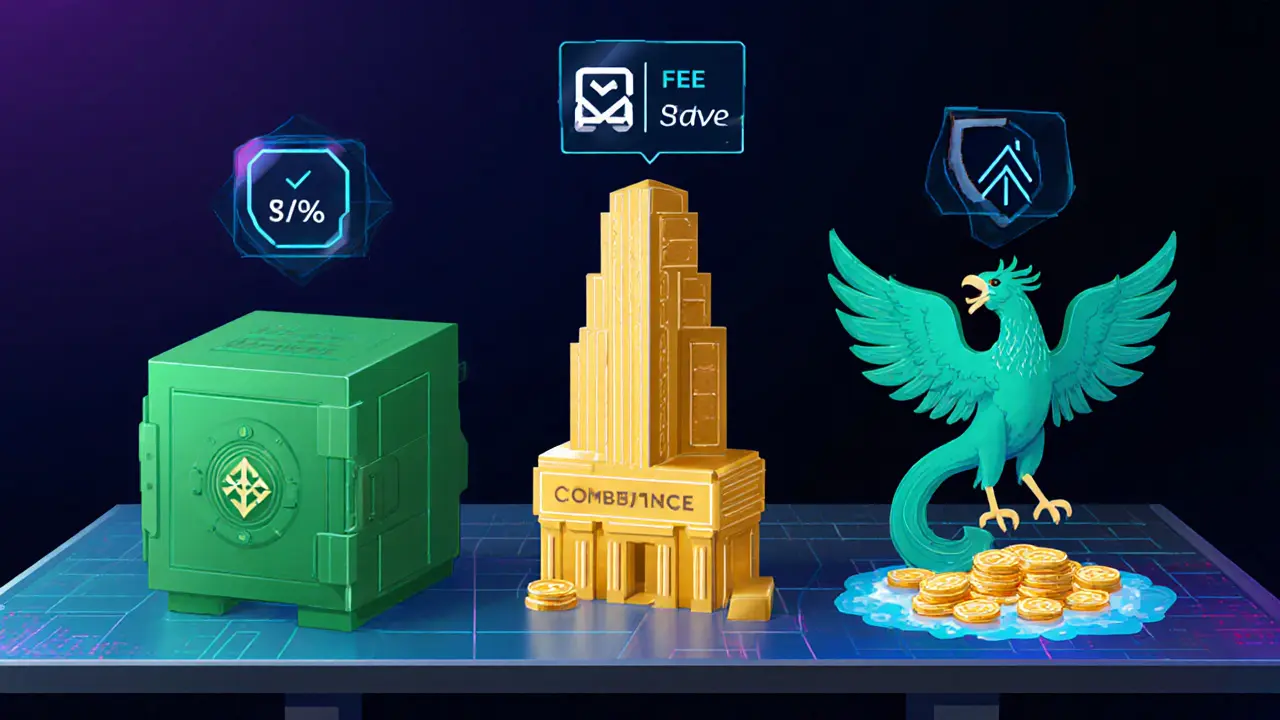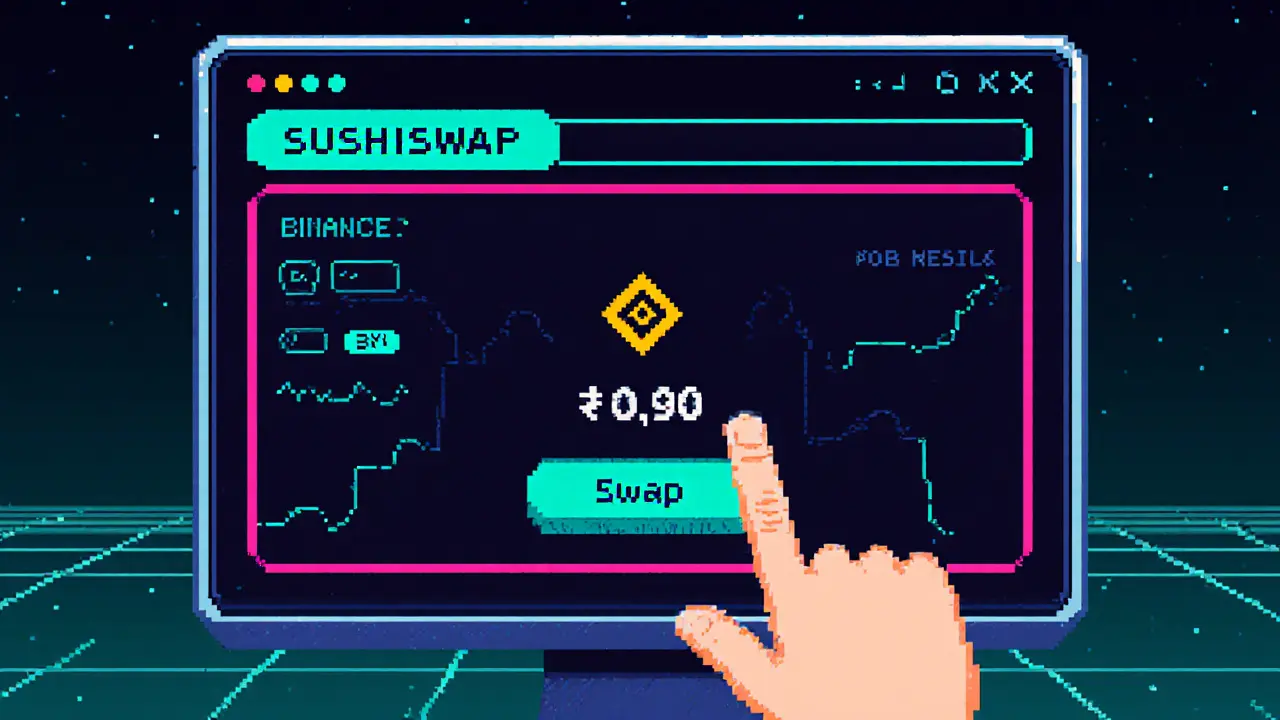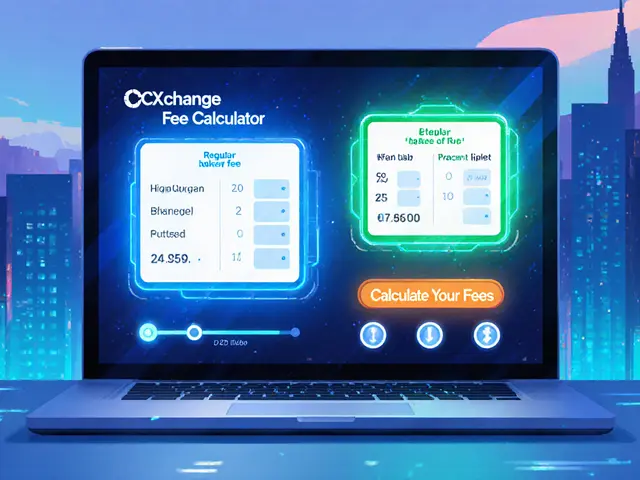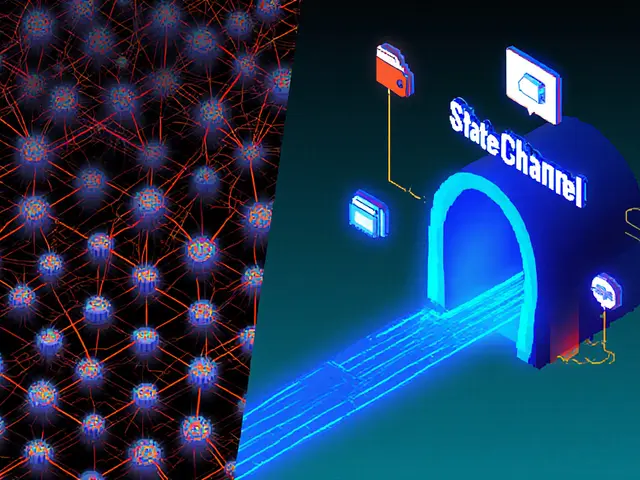Compound Crypto Interest Calculator
Your Potential Earnings
Projected Earnings
Important Note
This calculator estimates potential earnings based on current APY rates. Actual returns may vary due to changing market conditions, network congestion, and Compound's algorithmic interest rate adjustments.
When you type "Compound" into a search box, the first thing that pops up is a DeFi lending protocol, not a traditional crypto exchange. That mismatch often leaves newcomers wondering: Compound crypto exchange review - is there an exchange called Compound, or is it something else? This article clears the fog. We’ll define what Compound actually is, walk through how you can use it to trade, lend, and earn, compare it with the biggest centralized exchanges and other DeFi platforms, and give you a practical checklist so you can decide whether to add it to your crypto toolbox.
Key Takeaways
- Compound is a decentralized finance (DeFi) lending protocol, not a conventional crypto exchange.
- It lets you supply assets to earn interest and borrow against collateral via smart contracts.
- Fees are low (protocol fee 0.05%); you pay gas on the Ethereum network.
- Security relies on open‑source contracts audited by multiple firms; risks include smart‑contract bugs and market volatility.
- Compared to Binance, Coinbase, and Aave, Compound excels at simplicity and composability but lacks spot‑trading pairs and fiat on‑ramps.
Compound is a decentralized finance (DeFi) protocol that allows users to lend and borrow cryptocurrencies directly from smart contracts on the Ethereum blockchain. Launched in 2018 by a team of ex‑Google engineers, Compound introduced the concept of algorithmic interest rates, where supply and demand of each asset automatically set borrowing costs. Unlike a traditional crypto exchange that matches buyers and sellers in an order book, Compound acts as a money market: you deposit assets, earn cTokens that represent your claim, and can withdraw or borrow at any time.
How Compound Works: A Step‑by‑Step Walkthrough
- Connect a wallet. Use a Web3 wallet such as MetaMask or Ledger. The connection is non‑custodial - you keep your private keys.
- Supply assets. Choose from supported tokens (e.g., Ethereum (ETH), USDC, WBTC). When you click “Supply,” the protocol locks the token in a smart contract and mints a corresponding cToken (e.g., cETH) that accrues interest.
- Earn interest. Interest accrues every block, reflected in the exchange rate between the cToken and the underlying asset. No need to claim; your balance updates automatically.
- Borrow against collateral. After supplying enough collateral, you can borrow another asset up to a specific collateral factor (e.g., 75% for ETH). Borrowing incurs interest, also calculated algorithmically.
- Repay or withdraw. To close a position, repay the borrowed amount plus interest, then redeem cTokens for the original asset.
Key Features and Attributes
- Non‑custodial. Users retain full control over funds; Compound never holds private keys.
- Algorithmic rates. Supply‑APY and borrow‑APR adjust every block based on utilization.
- Composability. cTokens can be used as collateral in other DeFi protocols (e.g., for yield farming).
- Governance token. COMP token holders vote on protocol upgrades, fee structures, and new markets.
- Low protocol fee. 0.05% of interest earned is collected for the treasury.
- Ethereum‑first. Operates on Ethereum Mainnet, with Layer‑2 extensions (Optimism, Arbitrum) launching in 2025.

Comparing Compound with Centralized Exchanges and Other DeFi Platforms
| Feature | Compound (DeFi Lending) | Binance (CEX) | Aave (DeFi Lending) |
|---|---|---|---|
| Type | Non‑custodial money market | Centralized exchange with order book | Non‑custodial money market |
| Supported assets (2025) | ~30 major tokens (ETH, USDC, USDT, WBTC, DAI, LINK) | 350+ crypto pairs, fiat gateways | ~40 tokens, includes stablecoins and tokenized assets |
| Interest rates | Variable, 0.5‑12% APY on major assets | Spot trading fees 0‑0.1%; no native lending | Variable, 1‑15% APY, with rate switches |
| Fees | 0.05% protocol fee + Ethereum gas | 0‑0.1% trading fee, withdrawal fees | 0.05% protocol fee + gas |
| Security model | Audited smart contracts, DAO governance | Custodial wallets, insurance fund, KYC/AML | Audited contracts, risk‑tranche system |
| Regulatory status (UK/EU) | Unregulated DeFi; users bear compliance risk | Registered with FCA, complies with AML | Unregulated DeFi, similar to Compound |
Pros and Cons of Using Compound
Pros
- Full control of assets - no custodial risk.
- Earn passive income on idle crypto without selling.
- Interoperable with the broader DeFi ecosystem (e.g., you can feed cTokens into Curve or Yearn).
- Transparent governance via COMP token voting.
- Low protocol fee compared with many CeFi platforms.
Cons
- Gas fees on Ethereum can be high during network congestion.
- Smart‑contract bugs, though rare, can lead to loss of funds.
- No fiat on‑ramps; you must already own crypto.
- Limited asset list versus massive CEX inventories.
- Regulatory uncertainty - DeFi protocols are not licensed.
Safety Checklist Before You Jump In
- Verify you are on the official compound.finance domain (look for HTTPS and the correct URL). Phishing clones are common.
- Use a hardware wallet or a reputable non‑custodial software wallet. Keep your seed phrase offline.
- Check the latest audit reports (e.g., OpenZeppelin 2024 audit) for any critical findings.
- Assess gas price using Etherscan Gas Tracker. Consider Layer‑2 options if gas exceeds $10 per transaction.
- Start with a small amount (e.g., $100) to get comfortable with the supply/borrow flow.
Frequently Asked Questions
Is Compound a crypto exchange?
No. Compound is a DeFi lending protocol that lets you earn interest on supplied assets and borrow against collateral. It does not match buyers and sellers like a traditional exchange.
Do I need to buy COMP tokens to use Compound?
No. You can supply and borrow any supported asset without holding COMP. However, holding COMP lets you participate in governance and earn additional rewards.
What are the main risks of using Compound?
The biggest risks are smart‑contract bugs, extreme market volatility that can trigger liquidations, and high Ethereum gas fees that can eat into returns. Always diversify and keep an eye on collateral ratios.
Can I use Compound on Layer2 networks?
Yes. Since 2024, Compound has deployed contracts on Optimism and Arbitrum, offering lower fees and faster confirmations. The UI lets you switch networks with a dropdown.
How does Compound’s interest rate compare to a bank savings account?
Typical APY on popular stablecoins like USDC ranges from 2%‑4% on Compound, far above UK bank rates (<1% in 2025) but below some high‑yield CeFi platforms that offer up to 8% for large deposits.

Bottom Line: Should You Add Compound to Your Crypto Strategy?
If you already own Ethereum‑based tokens and want a hands‑off way to earn interest while keeping full custody, Compound is a solid choice. Its simplicity, low fees, and deep integration with the DeFi ecosystem make it a go‑to for passive income. However, if you need fiat on‑ramps, a wide selection of altcoins, or a regulated environment, a centralized exchange like Binance or Coinbase will serve you better. For most seasoned traders, the best approach is a hybrid: keep a portion of holdings on a CEX for liquidity and use Compound (or Aave) for the idle slice to capture higher yields.
Remember the safety checklist, start small, and monitor the evolving DeFi landscape. The crypto world moves fast, and staying informed is the best insurance against both market and technical risks.










Jacob Anderson
November 4, 2024 AT 18:02Oh great, another "review" that pretends to be groundbreaking. Compound's UI is about as user‑friendly as a rusted toolbox, and the APY numbers fluctuate more than my mood after a bad coffee.
Kate Nicholls
November 4, 2024 AT 22:12While the article does a decent job outlining the basic mechanics, it glosses over the risk of liquidation during market turbulence.
Richard Herman
November 5, 2024 AT 02:39I appreciate the effort to demystify the supply side; however, it would be helpful to include a section on how governance tokens influence rates across different markets.
Parker Dixon
November 5, 2024 AT 07:22Nice rundown! 👍 The calculator is a solid starting point, but remember to factor in gas fees-those can bite you hard. Also, keep an eye on the reserve factor; it plays a big role in your net yield. If you’re new, start with a modest amount and watch how the APY shifts over time.
Feel free to ask if you need a deeper dive into the math behind the rates. 😊
Stefano Benny
November 5, 2024 AT 12:22The author touts the "capped" APY as a strength, yet ignores the impact of reserve factor decay on net returns. In DeFi speak, that’s a red flag.
Bobby Ferew
November 5, 2024 AT 17:39Sure, the calculator looks pretty, but it doesn’t account for gas fees-something any realistic user should consider.
celester Johnson
November 5, 2024 AT 23:12One might argue that the pursuit of yield is the modern equivalent of Sisyphus' endless toil, especially when the protocol's algorithm reshapes rates like shifting sands.
Prince Chaudhary
November 6, 2024 AT 05:02Liquidity matters more than hype.
Mark Camden
November 6, 2024 AT 11:09From an ethical standpoint, users must scrutinize the underlying collateralization mechanisms to avoid unwittingly supporting predatory liquidation practices.
Evie View
November 6, 2024 AT 17:32If you think Compound is a safe haven, you’re living in a fantasy; the protocol’s historical crashes speak louder than any glossy UI.
Kate Roberge
November 7, 2024 AT 00:12Honestly, the piece feels like a marketing fluff piece-no deep dive into the oracle vulnerabilities.
Oreoluwa Towoju
November 7, 2024 AT 07:09Consider checking the reserve factor settings before allocating large sums; they directly affect your earned interest.
Amie Wilensky
November 7, 2024 AT 14:22Wow!!!, this article attempts to cover everything-yet, it omits the crucial detail of liquidation thresholds; indeed, clarity is paramount!!
Michael Wilkinson
November 7, 2024 AT 21:52Stop overlooking the impact of network congestion!
Clint Barnett
November 8, 2024 AT 05:39Compound has been a cornerstone of the DeFi lending ecosystem since its launch, offering users a way to earn passive income on a variety of assets. Its algorithmic interest rate model adjusts supply and borrow rates based on utilization, which in theory creates a market‑driven equilibrium. In practice, however, the utilization curves can produce abrupt jumps that catch borrowers off guard. The platform’s governance token, COMP, adds another layer of incentive, rewarding users proportionally to their activity. While this can boost overall returns, it also introduces token price volatility into the yield calculation. The review does a decent job of outlining the basic workflow, yet it glosses over the intricacies of the reward distribution schedule. For example, the clawback mechanism for COMP emissions can reduce expected APRs if the protocol’s emission rate is adjusted downward. Moreover, the reliance on a single price oracle exposes the system to potential manipulation, a risk that has manifested in past attacks. Users should therefore diversify their exposure across multiple lending platforms to mitigate oracle‑related risks. Another consideration is the gas cost on Ethereum, which can erode a significant portion of the nominal APY, especially for smaller deposits. Layer‑2 solutions and alternative chains are beginning to alleviate this issue, but Compound’s core contracts remain on L1 for now. The calculator featured in the article is a handy tool for quick estimates, yet it assumes static APY values that rarely hold true over longer horizons. Dynamic models that factor in projected utilization trends would provide a more realistic projection. Overall, Compound remains a solid option for yield seekers who understand its operational nuances and are comfortable with the inherent volatility. Proceed with due diligence, monitor the governance proposals, and never allocate more capital than you can afford to lose.
Rajini N
November 8, 2024 AT 09:49Great points, Parker! To add, the interest accrual on Compound is calculated per block, so the APY you see on the UI can lag behind real‑time changes. Also, keep an eye on the supply curve for each asset – a higher supply can push rates down, which the calculator doesn’t currently reflect. If you’re planning a sizable deposit, consider running a quick simulation with the on‑chain data to get a closer estimate.
Sidharth Praveen
November 8, 2024 AT 13:59Spot on, Oreoluwa! A tiny tweak like checking the reserve factor can make a big difference, and staying optimistic about the future of DeFi will keep you exploring better strategies.
Carl Robertson
November 8, 2024 AT 18:09Oh, Clint, you really went all in with the drama! While your 15‑sentence epic is impressive, the real issue is that most casual users never read that far. They just glance at the headline and hope for the best. So, the theatrical flair, while entertaining, doesn’t solve the core problem of accessibility.